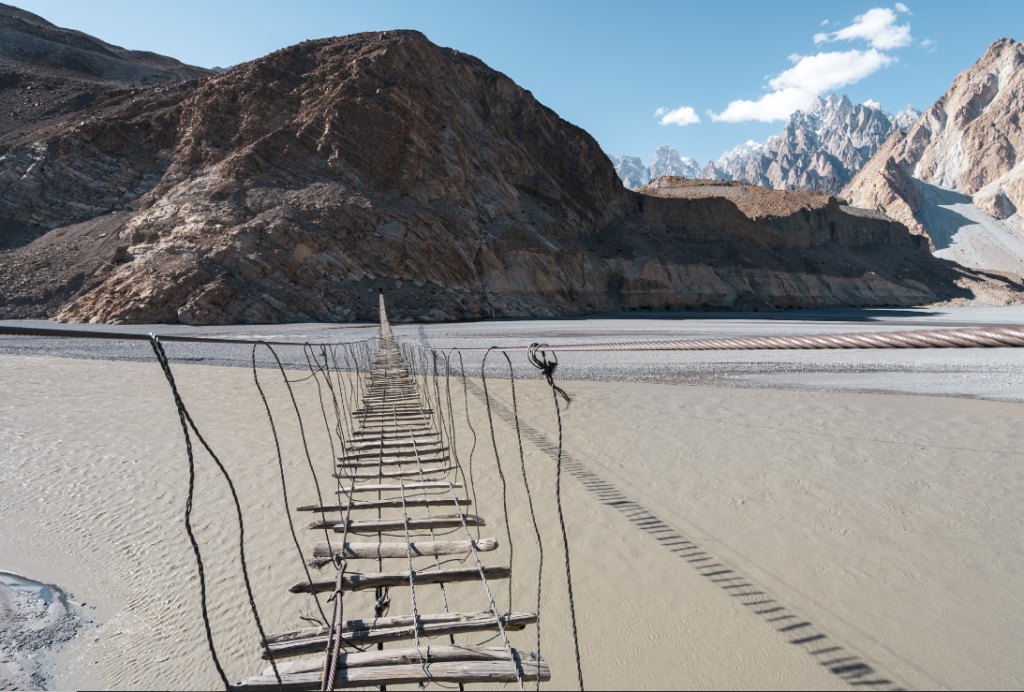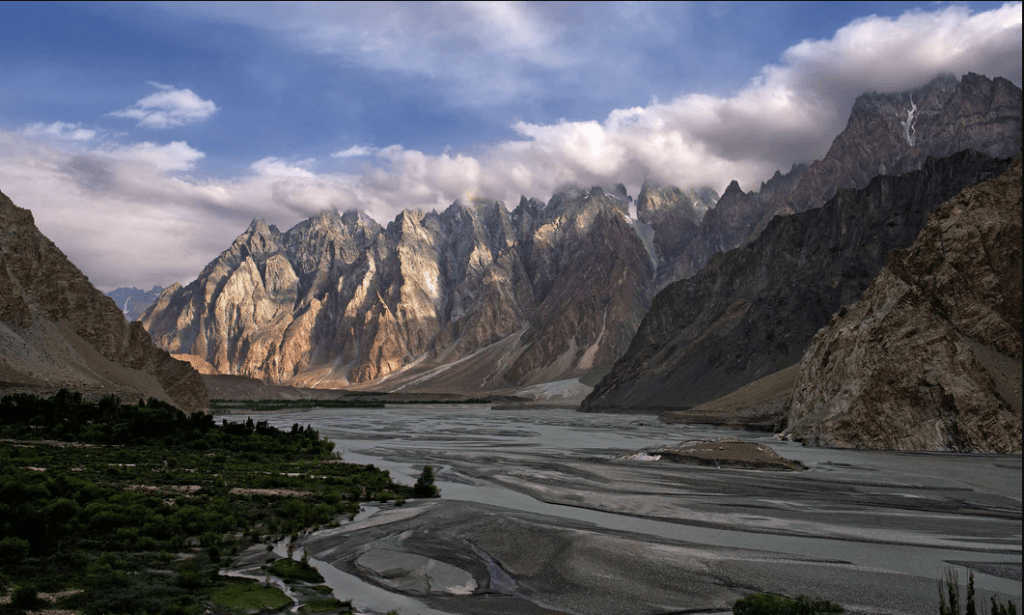
Located in the remote landscapes of Gilgit-Baltistan in northern Pakistan, the Passu Suspension Bridge is a thrilling and stunning destination for adventure seekers and nature lovers. Spanning the Hunza River, this bridge offers breathtaking views of the surrounding mountains, including the famous Passu Cones, and has become a popular tourist spot in recent years. The bridge is a combination of natural beauty and thrill.
The Passu Suspension Bridge was built to facilitate the local population to access otherwise remote areas across the Hunza River. Before it became a tourist spot, it was a vital link for the communities in the region. Although simple in design, it has a historic charm and speaks volume of the ingenuity of the local builders and their response to the mountain life.
The bridge is located near the small village of Passu in the Hunza Valley. Famous for its natural beauty, the valley is flanked by some of the highest peaks in the world, including the dramatic Passu Cones. This is part of the greater Karakoram Range and is near the Karakoram Highway, which connects Pakistan with China, making it relatively accessible to adventurous tourists.
The bridge is made of rope and wooden planks and is 510 feet (155 meters) long. It has a minimalist design with spaced out wooden planks which adds to the thrill and requires balance when crossing. The suspension ropes are robust but give a noticeable sway underfoot, especially when the wind is strong. This is simple and effective, provides crossing while keeping the environment intact. The bridge is 510 feet (155 meters) long and 30 feet (9 meters) above the river which fluctuates in level according to the season. Its width is just enough to accommodate one person at a time, making it an intimate and sometimes intimidating experience for those who cross.
The Hunza River with its fast flowing icy waters is a dominant feature of this region. Its unpredictable currents and sheer power requires a stable crossing option for the locals, that’s why the bridge is essential. Although modern infrastructure has developed nearby, the Passu Suspension Bridge remains a symbol of connectivity and resilience for the local population.

Passu is famous for its beauty, with the dramatic Passu Cones standing tall against the sky and glaciers dotted all over the landscape. The natural beauty of the area combined with the adventure of the bridge attracts photographers, hikers and cultural enthusiasts. The bridge provides a viewpoint to see the raw beauty of the Hunza Valley, make it a must visit for those who want to experience Pakistan’s north.
Crossing the Passu Suspension Bridge is a thrill. The wooden planks are far enough apart to give you a glimpse of the river below, making it even more exciting for those who are trekking. Hold onto the rope railings and move slow, especially on windy days as the bridge sways a lot. Sturdy footwear and a cautious mind is a must for those who dare to cross.
The bridge’s sway and height above the river makes it a must visit for adventure seekers. The lack of sides and the simple plank and rope construction adds to the adrenaline rush. For those who want to get away from the conventional tourist destinations and immerse themselves in the raw and untouched landscapes, the bridge is an experience of a lifetime.
The weather in Hunza Valley changes drastically with the seasons and these changes can affect the access to Passu Suspension Bridge. Winter snow and spring floods can sometimes make the bridge inaccessible or even risky. Please check the local weather and consult with locals or guides before crossing during inclement weather.
Apart from the bridge, Hunza Valley has many other attractions. Near the bridge is the Passu Glacier, a stunning but challenging destination for those who want to explore the icy landscape. Borith Lake is also nearby, a peaceful spot to reflect amidst the majestic mountains. These along with Karakoram Highway makes the overall experience for the travelers to this part of the world more enriching.
The bridge has no modern safety features, which is part of its charm but also a concern for the travelers. It’s maintained by the locals who use it regularly. For tourists, following the safety guidelines such as crossing one at a time, move slow and avoid extreme weather conditions is a must.

Social media has played a big role in popularizing the bridge. Visitors often take breathtaking shots of the bridge and the surrounding landscapes making it a popular subject on Instagram and travel blogs. For photographers, the bridge is an ideal subject with the dramatic backdrop of Hunza Valley.
Passu is accessible via Karakoram Highway and can be reached by road from major cities of Pakistan like Islamabad. Best time to visit is during the warmer months from May to October. Accommodations can be found in nearby towns like Karimabad where guesthouses and hotels cater to tourists.
As tourism in Hunza Valley increases, the local ecosystem is facing growing pressure. Responsible tourism is encouraged to protect the environment and preserve its beauty for future generations. Efforts include eco-friendly practices and awareness campaigns to minimize the impact of visitors on this pristine region.
FAQs about Passu Suspension Bridge
Q1: How high is the Passu Suspension Bridge?
The bridge stands about 30 feet (9 meters) above the Hunza River, providing dramatic views of the valley.
Is the Passu Suspension Bridge safe to cross?
While safe for locals accustomed to it, visitors should exercise caution due to the bridge’s sway and height. Avoid crossing during strong winds or adverse weather.
How long does it take to cross the bridge?
It generally takes about 10-15 minutes to cross, depending on the speed and confidence of the person crossing.
When is the best time to visit?
The best time to visit is between May and October, when the weather is warmer and safer for outdoor activities.
Are there any fees for crossing the bridge?
There is no entry fee, but tourists are encouraged to respect local customs and the natural environment.
Can I take photos on the bridge?
Yes, but it’s recommended to hold onto the railing and avoid sudden movements while taking pictures for safety.

